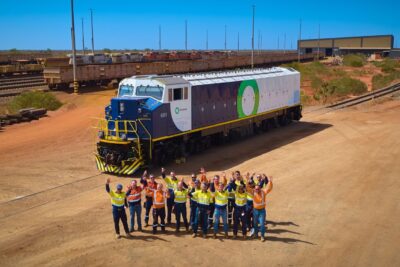
The Mobility House: navigating America’s shifting EV landscape
Gregor Hintler, CEO of The Mobility House North America, says the current landscape is shaped by both opportunity and risk. While federal programmes such as the Biden administration’s Bipartisan Infrastructure Law and the EPA’s Clean School Bus Program initially fuelled large-scale deployment, these funds are drying up. Hintler emphasises that most federally funded programmes for EV infrastructure are being phased out, with significant consequences for public sector projects in the coming years.
Microgrids as political insurance
In Maryland’s Montgomery County, The Mobility House is part of a flagship microgrid project that demonstrates how infrastructure can be future-proofed against policy reversals. The Brookville Smart Energy Bus Depot integrates solar panels, battery storage, gas generation, and The Mobility House’s smart charging software ‘ChargePilot’ into a unified microgrid. Featuring two megawatts of solar capacity, a four megawatt-hour stationary storage system, and 56 charge points, including 17 Heliox stations, two pantograph chargers and four Proterra chargers, the site ensures operational continuity even during grid outages.
Hintler views such projects as more than technical milestones. For him, microgrids are a political and economic statement. “This project represents resilience, not just operationally, but politically,” says Hintler. “It was designed to work independently of the grid—and that’s symbolic of where we see the market heading.”
By operating independently of the grid, they guarantee fleet readiness despite external shocks. ChargePilot ensures dynamic load management, distributing available power based on each vehicle’s state of charge and departure schedule. If the depot switches to island mode with limited capacity, the software automatically prioritises essential charging to maintain fleet operations.
US project portfolio diversifies
Hintler notes that these deployments demonstrate ChargePilot’s flexibility across different fleet types and grid contexts, from school districts to major urban bus networks and airport shuttles.
Beyond Montgomery County, The Mobility House is involved in multiple projects across North America. In New York City, for example, its ChargePilot software is managing depot charging for the Metropolitan Transportation Authority’s growing electric bus fleet. In California, the company supports the Turlock Unified School District near San Jose, which operates electric buses with advanced load management to reduce grid impact. And just as another example, Oakland Airport, California, also teamed up with The Mobility House to charge its electric shuttle buses.
State-led momentum and market bifurcation
While federal grants diminish, progressive states continue to drive electrification. California, New York, and Massachusetts remain committed to their climate targets, generating local demand even as Republican-led legislatures seek to cancel or delay programmes such as Advanced Clean Trucks (ACT) and Advanced Clean Fleets (ACF). Hintler warns that repealing these regulations would eliminate fleet transition mandates, stalling market growth in affected states.


“Most of the federally funded programs for EV infrastructure are being phased out. That’s not a projection—it’s a reality,” Hintler says. However, sectors such as commercial logistics, waste management, and private shuttles remain economically viable for electrification without subsidies.
The Mobility House is increasingly targeting these resilient markets alongside public transit and school bus projects. Hintler notes that the economics of electrification in heavy-duty fleets are improving rapidly due to reduced battery costs, improved vehicle range, and operational savings on fuel and maintenance.
Private sector bullishness offsets public caution
Despite public sector hesitancy, OEM and private fleet investment remains strong. Nearly 200 billion US dollars have been committed to EV and battery production domestically, with new factories coming online nationwide. Hintler observes that manufacturers often understate their progress publicly to avoid political backlash but remain fully committed to electrification strategies. “But behind the scenes, no one’s pulling back,” Hintler says.
This bifurcation between a cautious public sector and an assertive private sector demands strategic flexibility. The Mobility House is prioritising fleet operators who can extract operational returns independent of grants. While school bus projects remain politically attractive, they are vulnerable to funding cuts. Waste, logistics, and private shuttle fleets continue electrification plans regardless of federal policy shifts.
Designing for policy fragility
Hintler emphasises that in a post-support era, technology must compensate for the lack of regulatory carrots and sticks. Software-driven optimisation becomes critical when electrification must stand on its own merits. ChargePilot’s flexibility in grid-connected and microgrid-integrated modes is central to this strategy, ensuring vehicles are charged efficiently regardless of policy shocks or grid constraints.
Beyond the US, The Mobility House maintains buffers through international diversification. Projects in Singapore, Thailand, and India provide stable proof points of fleet electrification success, even if US momentum slows. In Europe, the company continues to manage some of the continent’s largest depot charging operations, including V2G pilots in Germany and the Netherlands.
For Hintler, this global reach reinforces a simple reality. Decarbonisation is progressing even if the route is no longer linear. The underlying economics, manufacturing commitments, and international direction remain too strong to reverse. The challenge now is adaptation – designing solutions that work despite policy fragility.
He concludes that what is needed is strategic realism. The path forward is about resilience, integrating technological flexibility with market pragmatism. Projects such as Montgomery County’s microgrid show that The Mobility House is already building this future, one depot at a time.




0 Comments